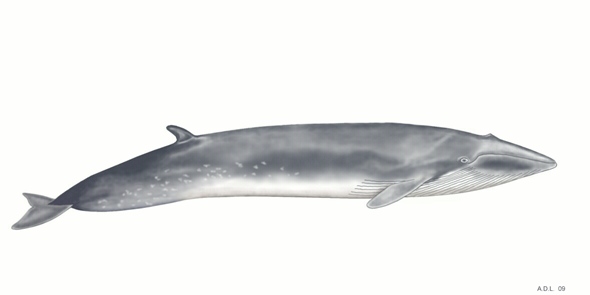Species Index


Key Facts
Length: Up to 19.5 metresRange: Patchy global distribution, absent in polar regions
Threats: Marine litter, acoustic disturbance, pollution
Diet: Plankton, small fish and squid
Sei Whale
Latin: Balaenoptera borealis
Gaelic: Muc-mhara-sei
Physical Description
The sei whale has a large, sleek body that can measure up to 19.5 metres in length. The dorsal fin is relatively large and curved, and is positioned about two-thirds back along the body. Sei whales do not raise their tail flukes above the water when diving. The blow is tall and columnar and is visible at the same time as the dorsal fin when the whale surfaces. Colouration is dark grey on the upper side with a light underside. There are often circular scars on the skin which are thought to be caused by predators or parasites.
Habitat and Distribution
The global distribution of sei whales is unpredictable and poorly understood. They occur throughout all major oceans worldwide, except the polar regions, although they are known for their sudden influxes to an area and subsequent disappearances. Migration patterns and population divisions are also poorly understood. Sei whales are predominantly an offshore species; they are rare in Hebridean waters and records include stranded animals.
Behaviour
Sei whales commonly travel alone or in small groups, although they can occur in larger groups where food is abundant. They are among the fastest of the large whales, capable of reaching speeds of 30 mph in short bursts. They occasionally breach (jump clear of the water).
Food and Foraging
The sei whale feeds by skimming the surface of the water to filter smaller prey such as zooplankton, as well as lunging at high speed into a concentration of small fish or squid. A sei whale will eat about 900 kg of prey each day. They regularly swim on their sides during feeding.
Status and Conservation
Following large-scale commercial hunts for sei whales, the worldwide population was estimated at about 54,000 animals in 2006. Threats to the species now include entanglement in, and ingestion of, marine litter, disturbance from boat traffic and acoustic interference. Sei whales are protected under UK and EU law, principally under Schedule 5 of the Wildlife and Countryside Act 1981, the Nature Conservation (Scotland) Act 2004 and by the 1992 EU Habitats and Species Directive.





